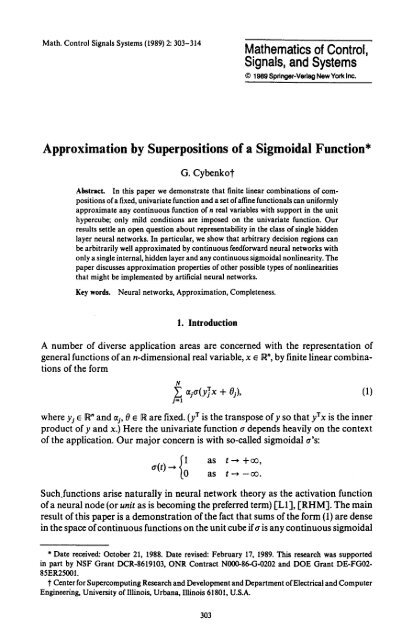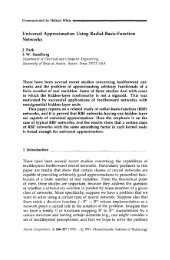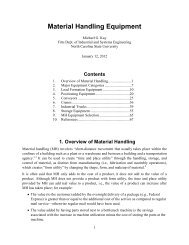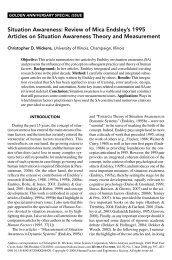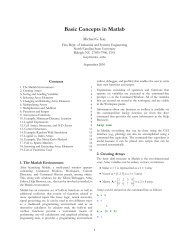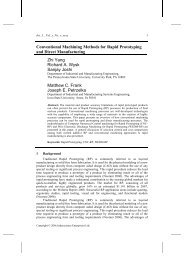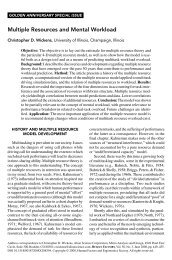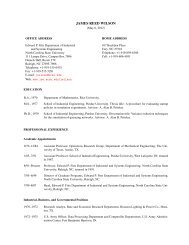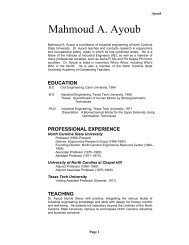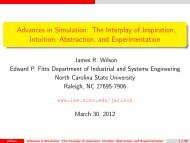Approximation by superpositions of a sigmoidal function
Approximation by superpositions of a sigmoidal function
Approximation by superpositions of a sigmoidal function
Create successful ePaper yourself
Turn your PDF publications into a flip-book with our unique Google optimized e-Paper software.
Math. Control Signals Systems (1989) 2:303-314<br />
Mathematics <strong>of</strong> Control,<br />
Signals, and Systems<br />
9 1989 Springer-Verlag New York Inc.<br />
<strong>Approximation</strong> <strong>by</strong> Superpositions <strong>of</strong> a Sigmoidal Function*<br />
G. Cybenkot<br />
Abstr,,ct. In this paper we demonstrate that finite linear combinations <strong>of</strong> compositions<br />
<strong>of</strong> a fixed, univariate <strong>function</strong> and a set <strong>of</strong>affine <strong>function</strong>als can uniformly<br />
approximate any continuous <strong>function</strong> <strong>of</strong> n real variables with support in the unit<br />
hypercube; only mild conditions are imposed on the univariate <strong>function</strong>. Our<br />
results settle an open question about representability in the class <strong>of</strong> single bidden<br />
layer neural networks. In particular, we show that arbitrary decision regions can<br />
be arbitrarily well approximated <strong>by</strong> continuous feedforward neural networks with<br />
only a single internal, hidden layer and any continuous <strong>sigmoidal</strong> nonlinearity. The<br />
paper discusses approximation properties <strong>of</strong> other possible types <strong>of</strong> nonlinearities<br />
that might be implemented <strong>by</strong> artificial neural networks.<br />
Key words. Neural networks, <strong>Approximation</strong>, Completeness.<br />
1. Introduction<br />
A number <strong>of</strong> diverse application areas are concerned with the representation <strong>of</strong><br />
general <strong>function</strong>s <strong>of</strong> an n-dimensional real variable, x 9 R", <strong>by</strong> finite linear combinations<br />
<strong>of</strong> the form<br />
N<br />
j=l<br />
+ or), (1)<br />
where yj 9 R" and ctj, 0 9 I~ are fixed. (yr is the transpose <strong>of</strong>y so that yrx is the inner<br />
product <strong>of</strong> y and x.) Here the univariate <strong>function</strong> tr depends heavily on the context<br />
<strong>of</strong> the application. Our major concern is with so-called <strong>sigmoidal</strong> a's:<br />
a(t)__,fl as t--, +~,<br />
as t --* -~.<br />
Such.<strong>function</strong>s arise naturally in neural network theory as the activation <strong>function</strong><br />
<strong>of</strong> a neural node (or unit as is becoming the preferred term) ILl], IRHM]. The main<br />
result <strong>of</strong> this paper is a demonstration <strong>of</strong> the fact that sums <strong>of</strong> the form (1) are dense<br />
in the space <strong>of</strong> continuous <strong>function</strong>s on the unit cube iftr is any continuous <strong>sigmoidal</strong><br />
* Date received: October 21, 1988. Date revised: February 17, 1989. This research was supported<br />
in part <strong>by</strong> NSF Grant DCR-8619103, ONR Contract N000-86-G-0202 and DOE Grant DE-FG02-<br />
85ER25001.<br />
t Center for Supercomputing Research and Development and Department <strong>of</strong> Electrical and Computer<br />
Engineering, University <strong>of</strong> Illinois, Urbana, Illinois 61801, U.S.A.<br />
303
304 G. Cybcnko<br />
<strong>function</strong>. This case is discussed in the most detail, but we state general conditions<br />
on other possible a's that guarantee similar results.<br />
The possible use <strong>of</strong> artificial neural networks in signal processing and control<br />
applications has generated considerable attention recently [B], I'G]. Loosely speaking,<br />
an artificial neural network is formed from compositions and <strong>superpositions</strong><br />
<strong>of</strong> a single, simple nonlinear activation or response <strong>function</strong>. Accordingly, the<br />
output <strong>of</strong> the network is the value <strong>of</strong> the <strong>function</strong> that results from that particular<br />
composition and superposition <strong>of</strong> the nonlinearities. In particular, the simplest<br />
nontrivial class <strong>of</strong> networks are those with one internal layer and they implement<br />
the class <strong>of</strong> <strong>function</strong>s given <strong>by</strong> (1). In applications such as pattern classification [L 1 ]<br />
and nonlinear prediction <strong>of</strong> time series iLF], for example, the goal is to select the<br />
compositions and <strong>superpositions</strong> appropriately so that desired network responses<br />
(meant to implement a classifying <strong>function</strong> or nonlinear predictor, respectively) are<br />
achieved.<br />
This leads to the problem <strong>of</strong> identifying the classes <strong>of</strong> <strong>function</strong>s that can be<br />
effectively realized <strong>by</strong> artificial neural networks. Similar problems are quite familiar<br />
and well studied in circuit theory and filter design where simple nonlinear devices<br />
are used to synthesize or approximate desired transfer <strong>function</strong>s. Thus, for example,<br />
a fundamental result in digital signal processing is the fact that digital filters made<br />
from unit delays and constant multipliers can approximate any continuous transfer<br />
<strong>function</strong> arbitrarily well. In this sense, the main result <strong>of</strong> this paper demonstrates<br />
that networks with only one internal layer and an arbitrary continuous <strong>sigmoidal</strong><br />
nonlinearity enjoy the same kind <strong>of</strong> universality.<br />
Requiring that finite linear combinations such as (1) exactly represent a given<br />
continuous <strong>function</strong> is asking for too much. In a well-known resolution <strong>of</strong> Hilbert's<br />
13th problem, Kolmogorov showed that all continuous <strong>function</strong>s <strong>of</strong>n variables have<br />
an exact representation in terms <strong>of</strong> finite <strong>superpositions</strong> and compositions <strong>of</strong> a small<br />
number <strong>of</strong> <strong>function</strong>s <strong>of</strong> one variable [K-I, [L2]. However, the Kolmogorov representation<br />
involves different nonlinear <strong>function</strong>s. The issue <strong>of</strong> exact representability has<br />
been further explored in [DS] in the context <strong>of</strong> projection pursuit methods for<br />
statistical data analysis IH].<br />
Our interest is in finite linear combinations involving the same univariate <strong>function</strong>.<br />
Moreover, we settle for approximations as opposed to exact representations.<br />
It is easy to see that in this light, (I) merely generalizes approximations <strong>by</strong> finite<br />
Fourier series. The mathematical tools for demonstrating such completeness properties<br />
typically fall into two categories: those that involve algebras <strong>of</strong> <strong>function</strong>s<br />
(leading to Stone-Weierstrass arguments l-A]) and those that involve translation<br />
invariant subspaces (leading to Tauberian theorems [R2]). We give examples <strong>of</strong><br />
each <strong>of</strong> these cases in this paper.<br />
Our main result settles a long-standing question about the exact class <strong>of</strong> decision<br />
regions that continuous valued, single hidden layer neural networks can implement.<br />
Some recent discussions <strong>of</strong> this question are in [HL1], [HL2], [MSJ], and [WL]<br />
while IN] contains one <strong>of</strong> the early rigorous analyses. In IN] Nilsson showed that<br />
any set <strong>of</strong> M points can be partitioned into two arbitrary subsets <strong>by</strong> a network with<br />
one internal layer. There has been growing evidence through examples and special
<strong>Approximation</strong> <strong>by</strong> Superpositions <strong>of</strong> a Sigmoidal Function 305<br />
cases that such networks can implement more general decision regions but a general<br />
theory has been missing. In [MS J-] Makhoul et al. have made a detailed geometric<br />
analysis <strong>of</strong> some <strong>of</strong> the decisions regions that can be constructed exactly with a<br />
single layer. By contrast, our work here shows that any collection <strong>of</strong> compact,<br />
disjoint subsets <strong>of</strong> R n can be discriminated with arbitrary precision. That result is<br />
contained in Theorem 3 and the subsequent discussion below.<br />
A number <strong>of</strong> other current works are devoted to the same kinds <strong>of</strong> questions<br />
addressed in this paper. In [HSW] Hornik et al. show that monotonic <strong>sigmoidal</strong><br />
<strong>function</strong>s in networks with single layers are complete in the space <strong>of</strong> continuous<br />
<strong>function</strong>s. Carroll and Dickinson [CD] show that the completeness property can<br />
be demonstrated constructively <strong>by</strong> using Radon transform ideas. Jones [J] outlines<br />
a simple constructive demonstration <strong>of</strong> completeness for arbitrary bounded<br />
<strong>sigmoidal</strong> <strong>function</strong>s. Funahashi [F] has given a demonstration involving Fourier<br />
analysis and Paley-Wiener theory. In earlier work [C], we gave a constructive<br />
mathematical pro<strong>of</strong> <strong>of</strong> the fact that continuous neural networks with two hidden<br />
layers can approximate arbitrary continuous <strong>function</strong>s.<br />
The main techniques that we use are drawn from standard <strong>function</strong>al analysis.<br />
The pro<strong>of</strong> <strong>of</strong> the main theorem goes as follows. We start <strong>by</strong> noting that finite<br />
summations <strong>of</strong> the form (1) determine a subspace in the space <strong>of</strong> all continuous<br />
<strong>function</strong>s on the unit hypercube <strong>of</strong> R n. Using the Hahn-Banach and Riesz Representation<br />
Theorems, we show that the subspace is annihilated <strong>by</strong> a finite measure. The<br />
measure must also annihilate every term in (1) and this leads to the necessary<br />
conditions on ~r. All the basic <strong>function</strong>al analysis that we use can be found in [A],<br />
[R2-1 for example.<br />
The organization <strong>of</strong> this paper is as follows. In Section 2 we deal with preliminaries,<br />
state, and prove the major result <strong>of</strong> the paper. Most <strong>of</strong> the technical details<br />
<strong>of</strong> this paper are in Section 2. In Section 3 we specialize to the case <strong>of</strong> interest in<br />
neural network theory and develop the consequences. Section 4 is a discussion <strong>of</strong><br />
other types <strong>of</strong> <strong>function</strong>s, tr, that lead to similar results while Section 5 is a discussion<br />
and summary.<br />
2. Main Results<br />
Let In denote the n-dimensional unit cube, [0, 1] n. The space <strong>of</strong> continuous <strong>function</strong>s<br />
on In is denoted <strong>by</strong> C(ln) and we use Ilfll to denote the supremum (or uniform)<br />
norm <strong>of</strong> an f ~ C(ln). In general we use I1"11 to denote the maximum <strong>of</strong> a <strong>function</strong><br />
on its domain. The space <strong>of</strong> finite, signed regular Borel measures on In is denoted<br />
<strong>by</strong> M(ln). See JR2] for a presentation <strong>of</strong> these and other <strong>function</strong>al analysis constructions<br />
that we use.<br />
The main goal <strong>of</strong> this paper is to investigate conditions under which sums <strong>of</strong> the<br />
form<br />
N<br />
G(x) = ~ ct~a(yTx + 0 r)<br />
j=l<br />
are dense in C(ln) with respect to the supremum norm.
306 G. Cybenko<br />
Definition.<br />
We say that tr is discriminatory if for a measure/z ~ M(I.)<br />
t. a(ylrx + 0) dl~(x) = 0<br />
for all y e R" and 0 e R implies that/z = O.<br />
Definition.<br />
We say that a is <strong>sigmoidal</strong> if<br />
a(t)~fl as t--* +oo,<br />
to as t ~ -oo.<br />
Theorem 1.<br />
the form<br />
Let a be any continuous discriminatory <strong>function</strong>. Then finite sums <strong>of</strong><br />
N<br />
G(x) = ~ ~ja(y~x + Oj) (2)<br />
j=l<br />
are dense in C(I,). In other words, given any f ~ C(I,) and e > O, there is a sum, G(x),<br />
<strong>of</strong> the above form, for which<br />
IG(x) - f(x)l < e for all x ~1,.<br />
Pro<strong>of</strong>. Let S c C(I,) be the set <strong>of</strong> <strong>function</strong>s <strong>of</strong> the form G(x) as in (2). Clearly S is<br />
a linear subspace <strong>of</strong> C(I,). We claim that the closure <strong>of</strong> S is all <strong>of</strong> C(I,).<br />
Asgume that the closure <strong>of</strong> S is not all <strong>of</strong> C(In). Then the closure <strong>of</strong> S, say R, is a<br />
closed proper subspace <strong>of</strong> C(ln). By the Hahn-Banach theorem, there is a bounded<br />
linear <strong>function</strong>al on C(I,), call it L, with the property that L # 0 but L(R) = L(S) = O.<br />
By the Riesz Representation Theorem, this bounded linear <strong>function</strong>al, L, is <strong>of</strong> the<br />
form<br />
L(h) = f<br />
,11 n<br />
h(x) d#(x)<br />
for some # e M(ln), for all h e C(I,). In particular, since a(yrx + O) is in R for all y<br />
and 0, we must have that<br />
fta(YrX + O) d#(x) = 0<br />
n<br />
for all y and 0.<br />
However, we assumed that a was discriminatory so that this condition implies<br />
that/z = 0 contradicting our assumption. Hence, the subspace S must be dense in<br />
c(1,).<br />
9<br />
This demonstrates that sums <strong>of</strong> the form<br />
N<br />
are dense in C(I,) providing that a is continuous and discriminatory. The argument
<strong>Approximation</strong> <strong>by</strong> Superpositions <strong>of</strong> a Sigmoidal Function 307<br />
used was quite general and can be applied in other cases as discussed in Section 4.<br />
Now, we specialize this result to show that any continuous <strong>sigmoidal</strong> a <strong>of</strong> the form<br />
discussed before, namely<br />
tr(t)~fl as t-, +oo,<br />
t0 as t ~ --o0,<br />
is discriminatory. It is worth noting that, in neural network applications, continuous<br />
<strong>sigmoidal</strong> activation <strong>function</strong>s are typically taken to be monotonically increasing,<br />
but no monotonicity is required in our results.<br />
Lemma 1. Any bounded, measurable siomoidal <strong>function</strong>, a, is discriminatory. In<br />
particular, any continuous siomoidal <strong>function</strong> is discriminatory.<br />
Pro<strong>of</strong>.<br />
To demonstrate this, note that for any x, y, 0, ~p we have<br />
(~<br />
1 for yrx+O>O as 2--*+oo,<br />
a(2(yrx+O)+cp) 0 for yrx+OO,<br />
y(x) =0 for yrx+O 0}. Then <strong>by</strong> the Lesbegue Bounded Convergence<br />
Theorem, we have that<br />
0 = f ax(x) dlt(x)<br />
.11 n<br />
= [ r(x) d~(x)<br />
.11 n<br />
= a(~0)/~(n,,0) + u(n~,o)<br />
for all ~o, 0, y.<br />
We now show that the measure <strong>of</strong> all half-planes being 0 implies that the measure<br />
/a itself must be 0. This would be trivial if/~ were a positive measure but here it is not.<br />
Fix y. For a bounded measurable functon, h, define the linear <strong>function</strong>al, F,<br />
according to<br />
tB<br />
F(h) = j_ h(yrx) dlt(x)<br />
.1I n<br />
and note that F is a bounded <strong>function</strong>al on L| since # is a finite signed measure.<br />
Let h be the indicator funcion <strong>of</strong> the interval [0, oo) (that is, h(u) = 1 if u > 0 and
308 G. Cybenko<br />
h(u) = 0 if u < 0) so that<br />
F(h) = f h(yTx) d#(x) = #(I'ly,_s) +/~(Hy,_s) = 0.<br />
,11 n<br />
Similarly, F(h) = 0 if h is the indicator <strong>function</strong> <strong>of</strong> the open interval (0, 00). By<br />
linearity, F(h) = 0 for the indicator <strong>function</strong> <strong>of</strong> any interval and hence for any simple<br />
<strong>function</strong> (that is, sum <strong>of</strong> indicator functons <strong>of</strong> intervals). Since simple functons are<br />
dense in L~(R) (see p. 90 <strong>of</strong> [A]) F = 0.<br />
In particular, the bounded measurable <strong>function</strong>s s(u)= sin(m.u) and c(u)=<br />
cos(m" u) give<br />
F(s + ic) = f cos(mrx) + i sin(mrx)dlz(x) = f_ exp(imrx) dg(x) = 0<br />
.11 n Jim<br />
for all m. Thus, the Fourier transform <strong>of</strong> # is 0 and so # must be zero as well [R2,<br />
p. 176]. Hence, a is discriminatory. 9<br />
3. Application to Artificial Neural Networks<br />
In this section we apply the previous results to the case <strong>of</strong> most interest in neural<br />
network theory. A straightforward combination <strong>of</strong> Theorem I and Lemma 1 shows<br />
that networks with one internal layer and an arbitrary continuous <strong>sigmoidal</strong> <strong>function</strong><br />
can approximate continuous <strong>function</strong>s wtih arbitrary precision providing that<br />
no constraints are placed on the number <strong>of</strong> nodes or the size <strong>of</strong> the weights. This is<br />
Theorem 2 below. The consequences <strong>of</strong> that result for the approximation <strong>of</strong> decision<br />
<strong>function</strong>s for general decision regions is made afterwards.<br />
Theorem 2.<br />
form<br />
Let tr be any continuous <strong>sigmoidal</strong> <strong>function</strong>. Then finite sums <strong>of</strong> the<br />
N<br />
G(x) = Z<br />
j=l<br />
+ or)<br />
are dense in C(I~). In other words, given any f E C(I~) and e > O, there is a sum, G(x),<br />
<strong>of</strong> the above form, for which<br />
IG(x) - f(x)l < e for all x ~ In.<br />
Pro<strong>of</strong>. Combine Theorem 1 and Lemma 1, noting that continuous <strong>sigmoidal</strong>s<br />
satisfy the conditions <strong>of</strong> that lemma.<br />
9<br />
We now demonstrate the implications <strong>of</strong> these results in the context <strong>of</strong> decision<br />
regions. Let m denote Lesbeguc measure in I,. Let PI, P2 ..... Pk be a partition <strong>of</strong><br />
I, into k disjoint, measurable subsets <strong>of</strong> In. Define the decision <strong>function</strong>, f, according<br />
to<br />
f(x) = j<br />
if and only if x e Pj.<br />
This <strong>function</strong> f can be viewed as a decision <strong>function</strong> for classification: if f(x) = j,
<strong>Approximation</strong> <strong>by</strong> Superpositions <strong>of</strong> a Sigrnoidal Function 309<br />
then we know that x ~ P~ and we can classify x accordingly. The issue is whether<br />
such a decision <strong>function</strong> can be implemented <strong>by</strong> a network with a single internal<br />
layer.<br />
We have ihe following fundamental result.<br />
Theorem 3. Let a be a continuous <strong>sigmoidal</strong> <strong>function</strong>. Let f be the decision <strong>function</strong><br />
for any finite measurable partition <strong>of</strong> In. For any e > O, there is a finite sum <strong>of</strong> the<br />
form<br />
N<br />
G(x) = Y, + 0 r)<br />
j=l<br />
and a set D ~ In, so that re(D) > 1 - ~ and<br />
IG(x) - f(x)l < e for x ~ D.<br />
Pro<strong>of</strong>. By Lusin's theorem [R1], there is a continuous <strong>function</strong>, h, and a set D with<br />
re(D) > 1 - e so that h(x) = f(x) for x E D. Now h is continuous and so, <strong>by</strong> Theorem<br />
2, we can find a summation <strong>of</strong> the form <strong>of</strong> G above to satisfy IG(x) - h(x)l < e for<br />
all x e I~. Then for x E D, we have<br />
IG(x) - f(x)l = IG(x) - h(x)l < e.<br />
Because <strong>of</strong> continuity, we are always in the position <strong>of</strong> having to make some<br />
incorrect decisions about some points. This result states that the total measure <strong>of</strong><br />
the incorrectly classified points can be made arbitrarily small. In light <strong>of</strong> this,<br />
Thoerem 2 appears to be the strongest possible result <strong>of</strong> its kind.<br />
We can develop this approximation idea a bit more <strong>by</strong> considering the decision<br />
problem for a single closed set D c I~. Then f(x) = 1 if x E D and f(x) = 0 otherwise;<br />
f is the indicator <strong>function</strong> <strong>of</strong> the set D c I~. Suppose we wish to find a summation<br />
<strong>of</strong> the form (1) to approximate this decision <strong>function</strong>. Let<br />
A(x, D) = min{lx - Yl, Y ~ D}<br />
so that A(x, D) is a continuous <strong>function</strong> <strong>of</strong> x. Now set<br />
9<br />
~(x) = max 0,<br />
e<br />
so that f~(x) = 0 for points x farther than e away from D while f~(x) = 1 for x z D.<br />
Moreover, ~(x) is continuous in x.<br />
By Theorem 2, find a G(x) as in (1) so that IG(x) - ~(x)l < 89 and use this G as an<br />
approximate decision <strong>function</strong>: G(x) < 89 guesses that x E D c while G(x) >__ 89 guesses<br />
that x r D. This decision procedure is correct for all x ~ D and for all x at a distance<br />
at least ~ away from D. If x is within e distance <strong>of</strong> D, its classification depends on<br />
the particular choice <strong>of</strong> G(x).<br />
These observations say that points sufficiently far away from and points inside<br />
the closed decision region can be classified correctly. In contrast, Theorem 3 says<br />
that there is a network that makes the measure <strong>of</strong> points incorrectly classified as<br />
smat! as desired but does not guarantee their location.
310 G. Cybenko<br />
4. Results for Other Activation Functions<br />
In this section we discuss other classes <strong>of</strong> activation <strong>function</strong>s that have approximation<br />
properties similar to the ones enjoyed <strong>by</strong> continuous <strong>sigmoidal</strong>s. Since these<br />
other examples are <strong>of</strong> somewhat less practical interest, we only sketch the corresponding<br />
pro<strong>of</strong>s.<br />
There is considerable interest in discontinuous <strong>sigmoidal</strong> <strong>function</strong>s such as hard<br />
limiters (~(x) = 1 for x > 0 and a(x) = 0 for x < 0). Discontinuous <strong>sigmoidal</strong> <strong>function</strong>s<br />
are not used as <strong>of</strong>ten as continuous ones (because <strong>of</strong> the lack <strong>of</strong> good training<br />
algorithms) but they are <strong>of</strong> theoretical interest because <strong>of</strong> their close relationship to<br />
classical perceptrons and Gamba networks [MP].<br />
Assume that tr is a bounded, measurable <strong>sigmoidal</strong> <strong>function</strong>. We have an analog<br />
<strong>of</strong> Theorem 2 that goes as follows:<br />
Theorem 4.<br />
the form<br />
Let tr be bounded measurable <strong>sigmoidal</strong> <strong>function</strong>. Then finite sums <strong>of</strong><br />
Ig<br />
j=l<br />
are dense in LI(I.). In other words, given any f ~ LX(I~) and e > 0, there is a sum,<br />
G(x), <strong>of</strong> the above form for which<br />
/m<br />
JiG - filL, = { ]G(x) - f(x)[ dx < e.<br />
dl n<br />
The pro<strong>of</strong> follows the pro<strong>of</strong> <strong>of</strong> Theorems 1 and 2 with obvious changes such as<br />
replacing continuous <strong>function</strong>s <strong>by</strong> integrable <strong>function</strong>s and using the fact that L~(ln)<br />
is the dual .<strong>of</strong> L t (I,). The notion <strong>of</strong> being discriminatory accordingly changes to the<br />
following: for h E L~176 the condition that<br />
f a(yXx+ O)h(x)dx 0<br />
n<br />
for all y and 0 implies that h(x) = 0 almost everywhere. General <strong>sigmoidal</strong> <strong>function</strong>s<br />
are discriminatory in this sense as already seen in Lemma 1 because measures <strong>of</strong><br />
the form h(x) dx belong to M(ln).<br />
Since convergence in L t implies convergence in measure [A], we have an analog<br />
<strong>of</strong> Theorem 3 that goes as follows:<br />
Theorem 5. Let u be a general <strong>sigmoidal</strong> <strong>function</strong>. Let f be the decision <strong>function</strong><br />
for any finite measurable partition <strong>of</strong> In. For any 8 > O, there is a finite sum <strong>of</strong> the<br />
form<br />
U<br />
j=t<br />
and a set D c In, so that re(D) >_ 1 - e and<br />
IG(x) - f(x)l < for x D.<br />
A number <strong>of</strong> other possible activation <strong>function</strong>s can be shown to have approximation<br />
properties similar to those in Theorem 1 <strong>by</strong> simple use <strong>of</strong>tbe Stone-Weierstrass
<strong>Approximation</strong> <strong>by</strong> Superpositions <strong>of</strong> a Sigmoidal Function 311<br />
theorem I-A]. Those include the sine and cosine <strong>function</strong>s since linear combinations<br />
<strong>of</strong> sin(mr) and cos(mt) generate all finite trigonometric polynomials which are<br />
classically known to be complete in C(I.). Interestingly, the completeness <strong>of</strong> trigonometric<br />
polynomials was implicitly used in Lemma 1 when the Fourier transform's<br />
one-to-one mapping property (on distributions) was used. Another classical example<br />
is that <strong>of</strong> exponential <strong>function</strong>s, exp(mt), and the pro<strong>of</strong> again follows from direct<br />
application <strong>of</strong> the Stone-Weierstrass theorem. Exponential activation <strong>function</strong>s<br />
were studied <strong>by</strong> Palm in [P] where their completeness was shown.<br />
A whole other class <strong>of</strong> possible activation <strong>function</strong>s have completeness properties<br />
in LI(I.) as a result <strong>of</strong> the Wiener Tauberian theorem [R2]. For example, suppose<br />
that a is any L I(R) <strong>function</strong> with nonzero integral. Then summations <strong>of</strong> the form<br />
(1) are dense in Lt(R *) as the following outline shows.<br />
The analog <strong>of</strong> Theorem 1 carries through but we change C(I.) to LI(I.) and M(I.)<br />
to the corresponding dual space L~~ The analog <strong>of</strong> Theorem 3 holds if we can<br />
show that an integrable tr with nonzero integral is discriminatory in the sense that<br />
fla(yrx + O)h(x) dx = 0<br />
(3)<br />
n<br />
for all y and 0 implies that h = 0.<br />
To do this we proceed as follows. As in Lemma 1, define the bounded linear<br />
<strong>function</strong>al, F, on LI(I~) <strong>by</strong><br />
t~<br />
F(g) = l g(yrx) h(x) dx.<br />
,11 tt<br />
(Note that the integral exists since it is over I. and h is bounded. Specifically, if<br />
g ~ LI(R), then g(yrx) ~ LI(I.) for any y.)<br />
Letting ge,~(t) = a(st + 0), we see that<br />
F(go,s) = f_ a((sy)rx + O)h(x) dx = 0<br />
dl n<br />
so that F annihilates every translation and scaling <strong>of</strong> go, 1. Let f be the Fourier transform<br />
<strong>of</strong> f. By standard Fourier transform arguments, #0,,(z) = exp(izO/s)#(z/s)/s.<br />
Because <strong>of</strong> the scaling <strong>by</strong> s, the only z for which the Fourier transforms <strong>of</strong> all the<br />
go,s can vanish is z = 0 but we are assuming that Saa(t) dt = ~o,1(0) ~ 0. By the<br />
Wiener Tauberian theorem [R2], the subspace generated <strong>by</strong> the <strong>function</strong>s go,, is<br />
dense in Lt(R). Since F(ge.~) = 0 we must have that F = 0. Again, this implies that<br />
F(exp(imt)) = I_ exp(imt)h(t) dt = 0<br />
.11 n<br />
for all m and so the Fourier transform <strong>of</strong>h is 0. Thus h itself is 0. (Note that although<br />
the exponential <strong>function</strong> is not integrable over all <strong>of</strong> R, it is integrable over bounded<br />
regions and since h has support in I., that is sufficient.)<br />
The use <strong>of</strong> the Wiener Tauberian theorem leads to some other rather curious<br />
activation <strong>function</strong>s that have the completeness property in LI(I.). Consider the<br />
following activation <strong>function</strong> <strong>of</strong> n variables: tr(x) = 1 if x lies inside a finite fixed<br />
rectangle with sides parallel to the axes in R n and zero otherwise. Let U be an n x n<br />
orthogonal matrix and y E R n. Now a(Ux + y) is the indicator funciton <strong>of</strong> an
312 G. Cybenko<br />
arbitrarily oriented rectangle. Notice that no scaling <strong>of</strong> the rectangle is allowed--<br />
only rigid-body motions in Euclidean space! We then have that summations <strong>of</strong> the<br />
form<br />
N<br />
j=t<br />
~ja(Ujx + y~)<br />
are dense in LI(R"). This follows from direct application <strong>of</strong> the Wiener Tauberian<br />
theorem [R2] and the observation that the Fourier transform <strong>of</strong> a vanishes on a<br />
mesh in R" that does not include the origin. The intersection <strong>of</strong> all possible rotations<br />
<strong>of</strong> those meshes is empty and so a together with its rotations and translations<br />
generates a space dense in LI(Rn).<br />
This last result is closely related to the classical Pompeiu Problem [BST] and<br />
using the results <strong>of</strong> [BST-I we speculate that the rectangle in the above paragraph<br />
can be replaced <strong>by</strong> any convex set with a corner as defined in [BST].<br />
5. Summary<br />
We have demonstrated that finite <strong>superpositions</strong> <strong>of</strong> a fixed, univariate <strong>function</strong> that<br />
is discriminatory can uniformly approximate any continuous <strong>function</strong> <strong>of</strong> n real<br />
variables with support in the unit hypercube. Continuous <strong>sigmoidal</strong> <strong>function</strong>s <strong>of</strong><br />
the type commonly used in real-valued neural network theory are discriminatory.<br />
This combination <strong>of</strong> results demonstrates that any continuous <strong>function</strong> can be<br />
uniformly approximated <strong>by</strong> a continuous neural network having only one internal,<br />
hidden layer and with an arbitrary continuous <strong>sigmoidal</strong> nonlinearity (Theorem 2).<br />
Theorem 3 and the subsequent discussion show in a precise way that arbitrary<br />
decision <strong>function</strong>s can be arbitrarily well approximated <strong>by</strong> a neural network with<br />
one internal layer and a continuous <strong>sigmoidal</strong> nonlinearity.<br />
Table 1 summarizes the various contributions <strong>of</strong> which we are aware.<br />
Table 1<br />
Function type and<br />
transformations Function space References<br />
r + 0), a continuous C(I~)<br />
<strong>sigmoidal</strong>, y ~ R ~, 0 ~ R<br />
o(yTx + 0), cr monotonic<br />
C(l.)<br />
<strong>sigmoidal</strong>, y r R ~, 0 ~ R<br />
~(y~x + 0), o<br />
c(i.)<br />
<strong>sigmoidal</strong>, y ~ R ~, 0 e R<br />
a(yrx + 0), o ~ Lt(R)<br />
LI(I.)<br />
Scr(t) dt # O, yr R', 0 r R<br />
r + 0), r continuous L2(I~)<br />
<strong>sigmoidal</strong>, y e R n, 0 r R<br />
~(Ux + y), U e R "x",<br />
Lt(I.)<br />
y r R', Gr indicator <strong>of</strong> a rectangle<br />
a(tx + y), t r R, Gr r LI(R ") Lt(R ")<br />
y e H", S a(x) dx # 0<br />
This paper<br />
IF'J, [HSWJ<br />
if]<br />
This paper<br />
[co]<br />
This paper<br />
Wiener Tauberian<br />
theorem [R2]
<strong>Approximation</strong> <strong>by</strong> Superpositions <strong>of</strong> a Sigmoidal Function 313<br />
While the approximating properties we have described are quite powerful, we<br />
have focused only on existence. The important questions that remain to be answered<br />
deal with fe.asibility, namely how many terms in the summation (or equivalently,<br />
how many neural nodes) are required to yield an approximation <strong>of</strong> a given quality?<br />
What properties <strong>of</strong> the <strong>function</strong> being approximated play a role in determining the<br />
number <strong>of</strong> terms? At this point, we can only say that we suspect quite strongly that<br />
the overwhelming majority <strong>of</strong> approximation problems will require astronomical<br />
numbers <strong>of</strong> terms. This feeling is based on the curse <strong>of</strong> dimensionality that plagues<br />
multidimensional approximation theory and statistics. Some recent progress concerned<br />
with the relationship between a <strong>function</strong> being approximated and the number<br />
<strong>of</strong> terms needed for a suitable approximation can be found in [MS J] and [BH],<br />
[BEHW], and IV] for related problems. Given the conciseness <strong>of</strong> the results <strong>of</strong> this<br />
paper, we believe that these avenues <strong>of</strong> research deserve more attention.<br />
Acknowledgments. The author thanks Brad Dickinson, Christopher Chase, Lee<br />
Jones, Todd Quinto, Lee Rubel, John Makhoul, Alex Samarov, Richard Lippmann,<br />
and the anonymous referees for comments, additional references, and improvements<br />
in the presentation <strong>of</strong> this material.<br />
References<br />
[A] R. B. Ash, Real Analysis and Probability, Academic Press, New York, 197Z<br />
[BH] E. Baum and D. Haussler, What size net gives valid generalization?, Neural Comput. (to<br />
appear).<br />
[B] B. Bavarian (ed.), Special section on neural networks for systems and control, IEEE Control<br />
Systems Mag., 8 (April 1988), 3-31.<br />
['BEHW] A. Blumer, A. Ehrenfeucht, D. Haussler, and M. K. Warmuth, Classifying learnable geometric<br />
concepts with the Vapnik-Chervonenkis dimension, Proceedings <strong>of</strong> the 18th Annual ACM<br />
Symposium on Theory <strong>of</strong> Computing, Berkeley, CA, 1986, pp. 273-282.<br />
[BST] L. Brown, B. Schreiber, and B. A. Taylor, Spectral synthesis and the Pompeiu problem, Ann.<br />
Inst. Fourier (Grenoble), 23 (1973), 125-154.<br />
[CD] S. M. Carroll and B. W. Dickinson, Construction <strong>of</strong> neural nets using the Radon transform,<br />
preprint, 1989.<br />
[C] G. Cybenko, Continuous Valued Neural Networks with Two Hidden Layers are Sufficient,<br />
Technical Report, Department <strong>of</strong> Computer Science, Tufts University, 1988.<br />
[DS] P. Diaconis and M. Shahshahani, On nonlinear <strong>function</strong>s <strong>of</strong> linear combinations, SIAM J.<br />
Sci. Statist. Comput., 5 (1984), 175-191.<br />
IF] K. Funahashi, On the approximate realization <strong>of</strong> continuous mappings <strong>by</strong> neural networks,<br />
Neural Networks (to appear).<br />
[G] L. J. Griffiths (ed.), Special section on neural networks, IEEE Trans. Acoust. Speech Signal<br />
Process., 36 (1988), 1107-1190.<br />
[HSW] K. Hornik, M. Stinchcombe, and H. White, Multi-layer feedforward networks are universal<br />
approximators, preprint, 1988.<br />
[HLI] W. Y. Huang and R. P. Lippmann, Comparisons Between Neural Net and Conventional<br />
Classifiers, Technical Report, Lincoln Laboratory, MIT, 1987.<br />
[HL2] W. Y. Huang and R.P. Lippmann, Neural Net and Traditional Classifiers, Technical Report,<br />
Lincoln Laboratory, MIT, 1987.<br />
[HI P. J. Huber, Projection pursuit, Ann. Statist., 13 (1985), 435-475.<br />
[J] L. K. Jones, Constructive approximations for neural networks <strong>by</strong> <strong>sigmoidal</strong> <strong>function</strong>s,<br />
Technical Report Series, No. 7, Department <strong>of</strong> Mathematics, University <strong>of</strong> Lowell, 1988.
314 G. Cybenko<br />
[K]<br />
[LF]<br />
ILl]<br />
[L2]<br />
[MS J]<br />
[MP]<br />
[N]<br />
[P]<br />
JR1]<br />
[R2]<br />
[RHM]<br />
iv]<br />
[WL]<br />
A. N. Kolmogorov, On the representation <strong>of</strong> continuous <strong>function</strong>s <strong>of</strong> many variables <strong>by</strong><br />
superposition <strong>of</strong> continuous <strong>function</strong>s <strong>of</strong> one variable and addition, DokL Akad. Nauk. SSSR,<br />
114 (1957), 953-956.<br />
A. Lapedes and R. Farber, Nonlinear Signal Processing Using Neural Networks: Prediction<br />
and System Modeling, Technical Report, Theoretical Division, Los Alamos National Laboratory,<br />
1987.<br />
R. P. Lippmann, An introduction to computing with neural nets, IEEi~ ASSP Mag., 4<br />
(April 1987), 4-22.<br />
G. G. Lorentz, The 13th problem <strong>of</strong> Hilbert, in Mathematical Developments Arising from<br />
Hilbert's Problems (F. Browder, ed.), vol. 2, pp. 419-430, American Mathematical Society,<br />
Providence, RI, 1976.<br />
J. Makhoul, R. Schwartz, and A. EI-Jaroudi, Classification capabilities <strong>of</strong> two-layer neural<br />
nets. Proceedings <strong>of</strong> the IEEE International Conference on Acoustics, Speech, and Signal<br />
Processing, Glasgow, 1989 (to appear).<br />
M. Minsky and S. Papert, Perceptrons, MIT Press, Cambridge, MA, 1969.<br />
N. J. Nilsson, Learning Machines, McGraw-Hill, New York, 1965.<br />
G. Palm, On representation and approximation <strong>of</strong> nonlinear systems, Part II: Discrete<br />
systems, Biol. Cybernet., 34 (1979), 49-52.<br />
W. Rudin, Real and Complex Analysis, McGraw-Hill, New York, 1966.<br />
W. Rudin, Functional Analysis, McGraw-Hill, New York, 1973.<br />
D. E. Rumelhart, G. E. Hinton, and J. L. McClelland, A general framework for parallel<br />
distributed processing, in Parallel Distributed Processing: Explorations in the Microstructure<br />
<strong>of</strong> Cognition (D. E. Rumelhart, J. L. McClelland, and the PDP Research Group, eds.), vol. 1,<br />
pp. 45-76, MIT Press, Cambridge, MA, 1986.<br />
L. G. Valiant, A theory <strong>of</strong> the learnable, Comm. ACM, 27 (1984), 1134-1142.<br />
A Wieland and R. Leighton, Geometric analysis <strong>of</strong> neural network capabilities, Proceedings<br />
<strong>of</strong> IEEE First International Conference on Neural Networks, San Diego, CA, pp. II[-385-III-<br />
392, 1987.


